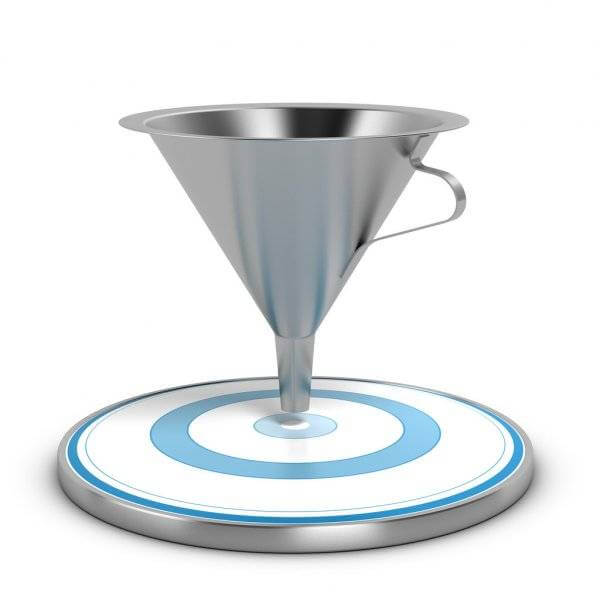
As a purchasing path for online stores and services, the conversion funnel is an integral part of optimizing conversion rates and achieving e-commerce success. The key to understanding your own metrics and conversion rates lies in gleaning unique, practical insights from your users. But in a world where literally everything is competing for a user’s attention, how do you get them to pay attention to you? By leveraging your company’s own conversion funnel to your advantage. With the right data, you can optimize every path to conversion on your website to ultimately improve conversion rates and vastly improve the customer experience. Here are a few ways conversion funnel tools can help accomplish these goals.
The Typical Conversion Funnel At A Glance
Conversion funnels are a big part of any marketing strategy and integral to understanding the journey your customers take along the way to a conversion. In traditional marketing, a conversion funnel usually operates on four different principles: attention, interest, desire, action. Essentially, you need to catch a customer’s attention to enter the funnel, find ways to generate interest and potential conversion points along the funnel, tell them why they should purchase a product, and finally provide a call to action that results in a successful conversion. Seems pretty straightforward, right? But a digital marketing conversion funnel might be laid out a bit differently. The goal of a conversion funnel is to help you understand and visualize how customers land on your website and eventually take action. A typical funnel might look like the entry point being visiting the site, followed by viewing a product, adding it to the cart, preparing for checkout, and making a purchase. Expanding on these points a bit more, the top of the funnel is where customer interest
The Importance Of Session Recording
Session recording is paramount to collecting quality data about customer behavior. When a customer accesses your website at the top of the funnel, you can immediately identify traffic sources and begin recording their actions from there. Session recording maps out pretty much everything the user does while on the website. This includes hovering over certain active links, clicking into various pages, placing items in the cart, beginning the checkout process, and filling out forms. A heat map can demonstrate where the user is clicking the mouse, how far down the page they scroll, where they hesitate, and inform what’s working on the website and what isn’t. This is useful for optimization but it also shows where paths to conversion points along your funnel are performing. You can assess this data and use it for A/B testing, hypothesis testing, making incremental improvements, and optimizing all of your conversion points.
Improving Conversion Rates
At each stage of the customer’s journey, you need to understand their behavior. Throughout the funnel, you can add certain types of pages such as product descriptions or customer testimonials that may create a path to conversion. Understanding conversion and click-through rate is also pretty important. If a customer clicks through to another page through the funnel, that is just one step closer to a full conversion. Calculating your conversion rate is as simple as dividing the number of conversions by the number of visitors to your site. Luckily, Using a conversion funnel optimization tool enables you to see these numbers at a glance and take action. It’s essential to look at these rates through the lens of both the entire funnel and individual funnel stages. Understanding these values informs any changes to a funnel stage, on page changes, or switching over to a new funnel design entirely. Funnels are only one part of the customer conversion experience, but they represent powerful testing and evaluation tool for understanding how customers eventually get there.
Reducing Drop Off
When you’re actually analyzing your funnel results, there are a couple of vectors to consider. These include drop off, conversion by each stage, and conversion throughout the entire funnel. You also need to think about how to retain customers after they’ve made a purchase. Whether it’s through referrals, asking for direct feedback, offering discounts, or other marketing initiatives, customer retention should be part of your funnel design. With funnel optimization tools, you can figure out ways to be successful in this area and also evaluate data on a customer by customer basis. Reducing drop off is essential to maintaining your conversion rates, something an analytical approach can help mitigate in the long term.
12 Month Analytics

The key to aggregating, analyzing, and understanding data is to have a large pool of it from which to draw your conclusions and test your hypotheses (similar to how a larger sample size can sometimes lead to an advantage in scientific studies). Imagine you have an idea to improve a funnel or to create a new, optimized one. By drawing on previous month’s worth of data, you can define a reference range and create a funnel to test out your hypothesis. The previous month’s worth of data informs the operation of the funnel so that you can optimize your results. You can do this over and over again until you achieve better optimization and gain deeper insights into your customer behavior.

Founder Dinis Guarda
IntelligentHQ Your New Business Network.
IntelligentHQ is a Business network and an expert source for finance, capital markets and intelligence for thousands of global business professionals, startups, and companies.
We exist at the point of intersection between technology, social media, finance and innovation.
IntelligentHQ leverages innovation and scale of social digital technology, analytics, news, and distribution to create an unparalleled, full digital medium and social business networks spectrum.
IntelligentHQ is working hard, to become a trusted, and indispensable source of business news and analytics, within financial services and its associated supply chains and ecosystems









